The Cathedral of Christ the Saviour
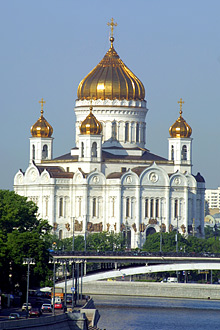 One of the most imposing buildings in Russia, the Cathedral of Christ the Saviour has had a short but terrible history. It was originally commissioned after the defeat of Napoleon, but work did not begin on its construction until 1839. Designed by the great St. Petersburg architect Konstantin Ton, who was also responsible for the Grand Kremlin Palace and the Kremlin Armoury and whose church designs pioneered the Byzantine-revival style. The cathedral was erected, for maximum effect, only a few minutes' walk from the Kremlin
One of the most imposing buildings in Russia, the Cathedral of Christ the Saviour has had a short but terrible history. It was originally commissioned after the defeat of Napoleon, but work did not begin on its construction until 1839. Designed by the great St. Petersburg architect Konstantin Ton, who was also responsible for the Grand Kremlin Palace and the Kremlin Armoury and whose church designs pioneered the Byzantine-revival style. The cathedral was erected, for maximum effect, only a few minutes' walk from the KremlinIts vast copper domes dominated the Moscow skyline.
The symbolic significance of the site was reaffirmed after the fall of the Soviet Union, when ambitious Moscow Mayor Yuri Luzhkov joined forces with the Orthodox Church to resurrect the cathedral in a $360-million reconstruction project. Completed in 2000, the new cathedral is loosely based on Ton's original designs, but constructed with modern building materials and fitted out with all mod-cons including air conditioning, telecommunications facilities, elevators and underground parking. Visitors can only see the cathedral as part of an organized tour, one of the highlights of which is the panoramic view from the 40-meter-high observation platform.
The St. Basil’s Cathedral
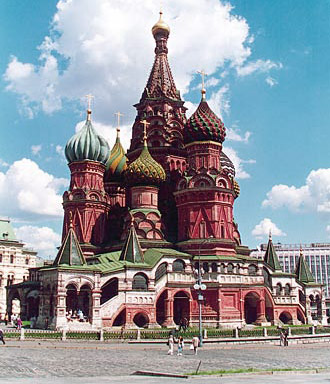 Although it's known to everyone as St. Basil's, this legendary building is officially called "The Cathedral of the Intercession of the Virgin by the Moat". The popular alternative refers to Basil the Blessed, a Muscovite 'holy fool' who was buried on the site (in the Trinity Cathedral that once stood here) a few years before the present building was erected.
Although it's known to everyone as St. Basil's, this legendary building is officially called "The Cathedral of the Intercession of the Virgin by the Moat". The popular alternative refers to Basil the Blessed, a Muscovite 'holy fool' who was buried on the site (in the Trinity Cathedral that once stood here) a few years before the present building was erected.The Cathedral was ordered by Ivan the Terrible to mark the 1552 capture of Kazan from Mongol forces. It was completed in 1560. Nothing is known about the builders, Barma and Postnik Yakovlev, except their names and the dubious legend that Ivan had them blinded so that they could not create anything to compare. Historians state that this is nothing but urban folklore.
The original concept of the Cathedral of the Intercession has been hidden from us beneath layers of stylistic additions and new churches added to the main building. In fact, when built, the Cathedral was all white to match the white-stone Kremlin, and the onion domes were gold rather than multi-colored and patterned as they are today.
In the 17th century a hip-roofed bell tower was added, the gallery and staircases were covered with vaulted roofing, and the helmeted domes were replaced with decorated ones. In 1860 during rebuilding, the Cathedral was painted with a more complex and integrated design.
The Cathedral is now a museum. During restoration work in the seventies a wooden spiral staircase was discovered within one of the walls. Visitors now take this route into the central church. You can also walk along the narrow, winding gallery, covered in beautiful patterned paintwork.
The Virgin of Kazan Cathedral
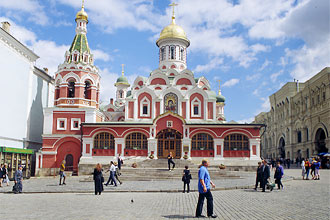 This small but charming Cathedral was built in the 17th century on the north side of the square near the Resurrection Gate. It was built to commemorate the repulsion of Polish invaders, and in honor of icon. One of the most revered icons in Moscow, it has been connected more than once with the struggle to protect Russia from her enemies.
This small but charming Cathedral was built in the 17th century on the north side of the square near the Resurrection Gate. It was built to commemorate the repulsion of Polish invaders, and in honor of icon. One of the most revered icons in Moscow, it has been connected more than once with the struggle to protect Russia from her enemies. In 1812, during the Napoleonic wars, a prayer service was conducted before the icon to plead for the safety of the country, and it was even attended by the great Russian commander, Field Marshal Mikhail Kutuzov.
The building is a cube topped with a cluster of domes and encircled by a gallery. In the north-west corner there is a bell-tower, and in the north-east the chapel of Averkiy Ierapolskiy. The Cathedral was restored between 1925 and 1933 by the great architect-restorer Pyotr Baranovsky. However, this did not stop the Soviet authorities from taking the decision in 1936 to have the Cathedral demolished.
Fortunately, thanks to Baranovsky, blueprints of the building survived, and in 1989 one of his former students, Oleg Zhurin, took charge of the project to rebuild the Cathedral. This was the first church to be rebuilt in post-communist Moscow. On 4 November 1990, Patriarch Aleksei II laid the first stone of the new building, and three years later the Cathedral was back in all its former glory.
The Cathedral of the Annunciation
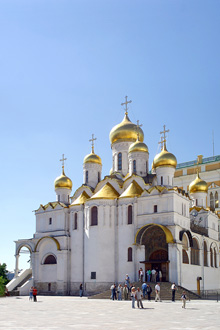 On the crest of Borovitsky Hill, at the south end of Sobornaya Ploshad (Cathedral Square), stands the Cathedral of the Annunciation.
On the crest of Borovitsky Hill, at the south end of Sobornaya Ploshad (Cathedral Square), stands the Cathedral of the Annunciation.The first church was built on this spot as early as 1397 by order of Grand Duke Vassily I. The present building dates from 1484, when Ivan III (the Great), the great Muscovite empire-builder, ordered a new cathedral on the site. It was completed in 1489 by Krivtsov and Mishkin, masons from Pskov, who blended Greek and Russian styles in their design.
Generations of princes and tsars added to and altered the Cathedral. Ivan IV (the Terrible) had the cathedral rebuilt in the 16th century and added four small side chapels, each with a single dome, while two more domes were added at the rear of the building and all nine domes were gilded. The Tsar was put under church penance when he married for the fourth time (three was the maximum the church would tolerate), and not allowed inside. This led to the construction of a new porch for him to stand under during services
The cathedral is famous for its magnificent iconostasis, shielding the sacred part of the church from view. Icons by various artists from the 14th to 19th centuries make up the screen. The Cathedral of the Annunciation was originally built as the domestic church of the Grand Dukes and tsars and was connected (along with the Cathedral of the Archangel) by passages to the private quarters of the royal family. The cathedral was used to celebrate name-days, weddings, baptisms and so forth. The Cathedral of the Annunciation was badly damaged during the Revolution, when the Kremlin came under attack from artillery fire. In 1918, the cathedral was closed as a place of worship and now it operates officially as a museum.
The Cathedral of the Assumption
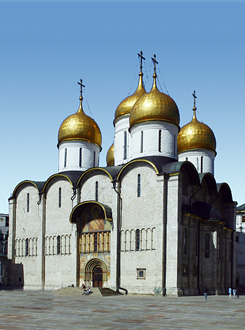 The Cathedral of the Assumption is the oldest church in the Kremlin and also the most important: the seat of the Russian Orthodox Church was transferred here from Vladimir in 1326, making it the centre of the state of Muscovy, and Muscovy the most powerful of the Russian principalities. Here Russian emperors were crowned, and before them tsars and Grand Dukes. Patriarchs (the highest rank of clergy), metropolitans (the church leaders of large metropolitan districts), and bishops were also consecrated here. Inside the cathedral, the Patriarch's Seat and the Throne of Monomakh - carved in 1551 for Ivan the Terrible - mark the physical presences of the two sides of this historic alliance.
The Cathedral of the Assumption is the oldest church in the Kremlin and also the most important: the seat of the Russian Orthodox Church was transferred here from Vladimir in 1326, making it the centre of the state of Muscovy, and Muscovy the most powerful of the Russian principalities. Here Russian emperors were crowned, and before them tsars and Grand Dukes. Patriarchs (the highest rank of clergy), metropolitans (the church leaders of large metropolitan districts), and bishops were also consecrated here. Inside the cathedral, the Patriarch's Seat and the Throne of Monomakh - carved in 1551 for Ivan the Terrible - mark the physical presences of the two sides of this historic alliance.The original cathedral was built during the reign of Ivan Kalita, whose strategic marriage to the daughter of the Tartar Khan brought Moscow to prominence. Chapels grew up around the small church and, in 1472, Ivan III, who was in the process of reconstructing the Kremlin to reflect the power of his new Russian state, the 'Third Rome', had a new building erected.
The building is simple and a vaulted limestone block topped by five golden cupolas. The gabled frescoes on the east and west faces were added in the 1660s.
Most of the frescoes in the Cathedral of the Assumption date back to the 17th century. Under a special edict from Tsar Mikhail Fyodorovich Romanov, issued in 1642, about a hundred and fifty artists were brought to Moscow from various towns to decorate the cathedral.
The Cathedral was closed and its treasures requisitioned by the Bolsheviks. However, when the Nazi troops arrived on the outskirts of Moscow in 1941, Stalin secretly allowed a service to be performed here to save the nation from deadly peril. The cathedral was reopened to the public in 1990.









